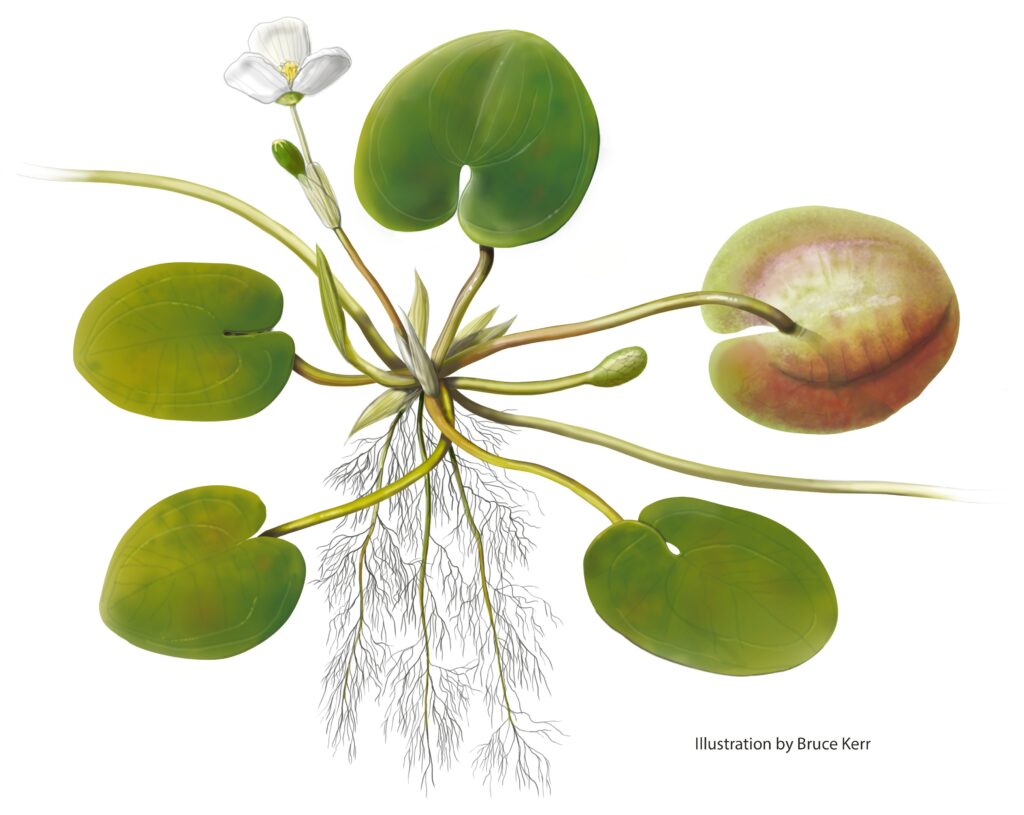What is European Frog-bit?
European frog-bit (Hydrocharis morsus-ranae; EFB) is an herbaceous, free-floating, freshwater plant that grows into 4-8 inch rosettes with heart-shaped leaves. The flowers have three white petals and a yellow center. EFB can form daughter plants connected by horizontal floating stems. Depending on location, EFB plants can exist as scattered rosettes interspersed among emergent and floating vegetation or they can grow into dense mats of interconnected rosettes.
Click each heading below to learn more about European frog-bit and what to do if you spot it within your jurisdiction.
Informational webinar
The European Frog-bit Collaborative and Great Lakes Phragmites Collaborative co-hosted a webinar to learn more about European frog-bit identification, biology/ecology, and what you can do to prevent, control, and report this invasive species.
Click below to watch the April 25th webinar: “European Frog-bit: An aquatic invasive plant often associated with Phragmites“, presented by Tom Alwin of the Michigan Department of Environment, Great Lakes, and Energy
BLANK
Growth & Reproduction
- European frog-bit flowers from mid- to late-summer. After a female flower is fertilized, a round, green fruit begins to develop and ripen underwater.
- Once ripe, internal pressure causes the fruit to split, releasing the seeds. Seeds sink to the lakebed where they remain until germination in the following growing season.
- In addition to sexual reproduction, EFB can reproduce asexually. Clonal daughter plants are produced throughout the growing season from buds at the tips of horizontal stems.
- EFB can also produce modified buds, called turions, that detach from the plant and sink to the lakebed. Turions remain on the substrate overwinter until conditions warm and they float to the surface. Turions produce new EFB plants in the spring and summer.
Potential Impacts
- European frog-bit can form dense, entangled, floating mats that cover the surface of the water.
- These mats have the potential to impact the human use of waterbodies by clogging navigation and irrigation channels and hindering recreation and commercial activities.
- These mats also have the potential to reduce light, dissolved gas, and nutrient availability in the water column below, and there is concern this can negatively impact native flora and fauna and lead to negative social, economic, and environmental impacts.
Habitat & Ecology
- European frog-bit can be found in wetlands associated with lakes, rivers, and streams, as well as artificial waterbodies such as canals, channels, ditches, and ponds. Within wetlands, it can colonize the emergent, floating, and submerged vegetation zones. In Great Lakes Coastal Wetlands, EFB is often associated with cattail and common reed, which shelter it from wind and wave action.
- EFB often occurs in nutrient-rich waters, but may establish in areas of varying water quality. You may commonly find EFB in manmade waterbodies with stagnant water or Great Lakes Coastal Wetlands intermixed with emergent vegetation.
Invasive Range
- European frog-bit was first documented outside of cultivation in North America in Ontario in 1939. It has since been recorded in Ontario, Quebec, New York, Vermont, Ohio, Michigan, Wisconsin, Maine, Pennsylvania, and Washington state.
- Within North America, EFB seems to be tolerant of a wide range of climatic conditions, making it a high-risk species for further spread.
How it Spreads
- European frog-bit’s free-floating habit allows it to drift with the water’s natural flow between connected waterbodies.
- EFB and its reproductive structures are also capable of spreading between waterbodies by accidental transportation via boat trailers and recreational equipment.
- Wildlife may contribute to EFB spread by becoming entangled in EFB rosettes or seeds and turions passing through the digestive tracts of waterfowl.
- It is also possible that EFB can be introduced through the improper disposal of plants in the water garden and aquarium trade.
How to report
If you think that you have encountered EFB, make sure to take one or several photos and note the location, date, and time of the observation. To report a single observation, refer to the Great Lakes reporting tools on the Reporting page; to learn about mapping and monitoring EFB populations using the EFB Collaborative delimitation and prioritization apps, refer to the Monitoring page.
What You Can Do
By becoming informed and sharing information about EFB, you can help change public awareness and perception of this invasive aquatic species. Some steps you can take to prevent the spread of EFB include:
- Decontaminate/wash watercraft, trailers, and gear between waterbodies
- Learn how to identify EFB
- Report EFB observations
- Teach others what you know about EFB
Resources & Publications
Twitter Image: Protect Habitat
European Frog-bit Collaborative
Twitter Image: Preserve Habitat
European Frog-bit Collaborative
Standard Treatment Impact Monitoring Protocol
European Frog-bit Collaborative

